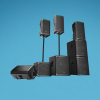
Rode AI-1 & NT1
Rode’s first audio interface is what the NT1 was to mics.
Rode previously had a couple of complete recording kits, but they were never really complete. Sure they had shockmounts, pop filters and cables, but they missed that link between your Rode mic and computer.
With new brands and models entering into the lower-cost end of the microphone market every month, Rode made a return to the top with its revitalised NT1. A product of the ‘vintage’-style capsule quest the manufacturer has been on, it wasn’t as peaky as the original NT1, the mic that started it all for the company, and generated less noise than an anechoic chamber.
Beyond the mic, there was the astoundingly good Rycote-infused shock mount, with its insertable fine mesh pop screen. It was the perfect starter mic, but it needed a companion. At the Freedman Electronics 50th birthday bash, Rode owner Peter Freedman AM announced a long list of future projects for the company. Most of them were high-end or ground-breaking in some way. Only one has seen the light of day so far; the neat VideoMic Pro+. There was never any mention of an interface, so it caught us by surprise when Rode announced the AI-1. A single-channel interface that debuted in a fully ‘Complete Studio Kit’ with the NT1. We should have seen it coming.
The AI-1 interface is a palm-sized black, powder-coated metal desktop unit that has just enough room to fit a combo XLR/1/4-inch input, two push-button knobs and a full-size headphone jack on the front. On the back are a stereo set of output jacks and a tiny USB-C connector. Thankfully, it comes with a USB-C to A cable in the box. Thoughtful for the majority of users, while future-proofing the connection. Nice move.
The AI-1 is bus-powered, which makes it uber-portable. Its single (mono) input automatically switches between mic and instrument level depending on what you’ve got plugged in. While it has two stereo outputs, it’s strictly one at a time; meaning you have to unplug your headphones to hear your monitors. It would have been nicer to have just one more switch.
Rode is expert at miniaturising control, having loads of experience cramming functions onto Videomic backplates. Likewise, the AI-1 is simple to navigate and well laid out.
There are four LEDs on the front. A signal LED with traffic-light colours to warn you when your signal is getting too hot. Press down on the gain knob and the red +48V phantom power LED will light up red when activated. Pressing down on the headphone/monitor level knob will switch between direct input and software monitoring.
Similar to most budget interfaces without their own ‘zero-latency’ mixer software, the option to monitor the direct input is the way to go. As a core audio device, even with a 32 sample buffer on my 2015 MacBook Pro, the latency wasn’t great for tracking. Direct monitoring is fine for recording with the microphone, but restricts the ability to use software guitar amp simulators. You’ll want to feed it some pedals on the way in if you need distortion and add the amp sim later.
The dynamic range (104dB) and gain range (45dB) on the AI-1 are decent for a USB bus-powered device, but aren’t the most impressive specs you’ll find on an interface, even in the single channel market. However, when paired with the Rode NT1, it’s a keen match. The self-noise… well there just isn’t any. It’s a hallmark of Rode’s designs that even the most affordable models deliver nothing other than the sound you put into them. Also, with the sensitivity of the NT1 being quite high, the 45dB gain range isn’t going to be an issue on any source.
Just to have a loads better quality headphone amp than what’s available on your computer is worth the sub-$200 price tag. It even drove my 250Ω Beyer open back headphones, which is a struggle for the MacBook Pro. The output level on the monitor side wasn’t quite as gutsy, but it is clean; which is better than loud and distorted. It goes all the way up to 96kHz sampling rate, and is a great addition to the Rode line of very useful devices.

























RESPONSES